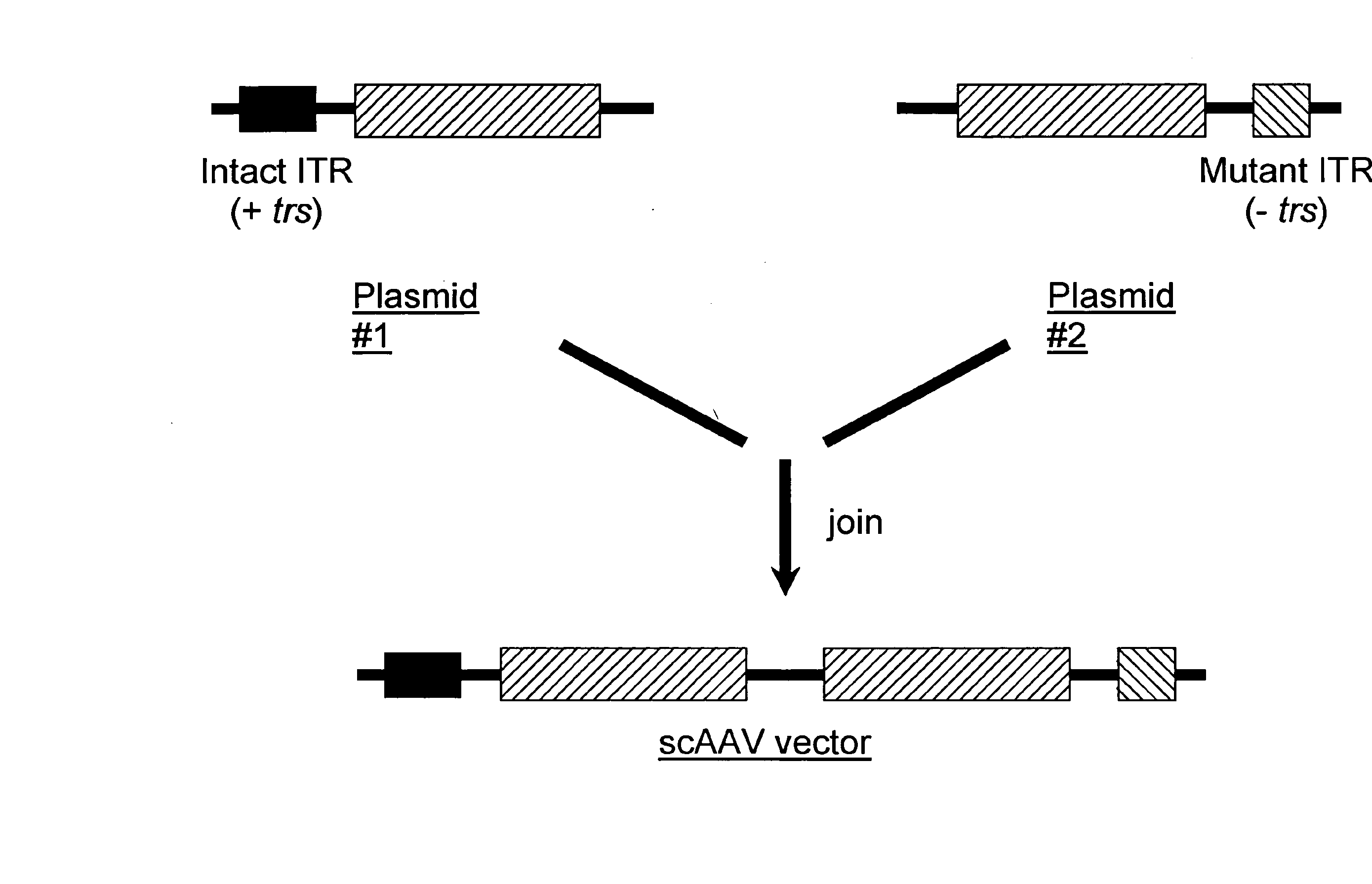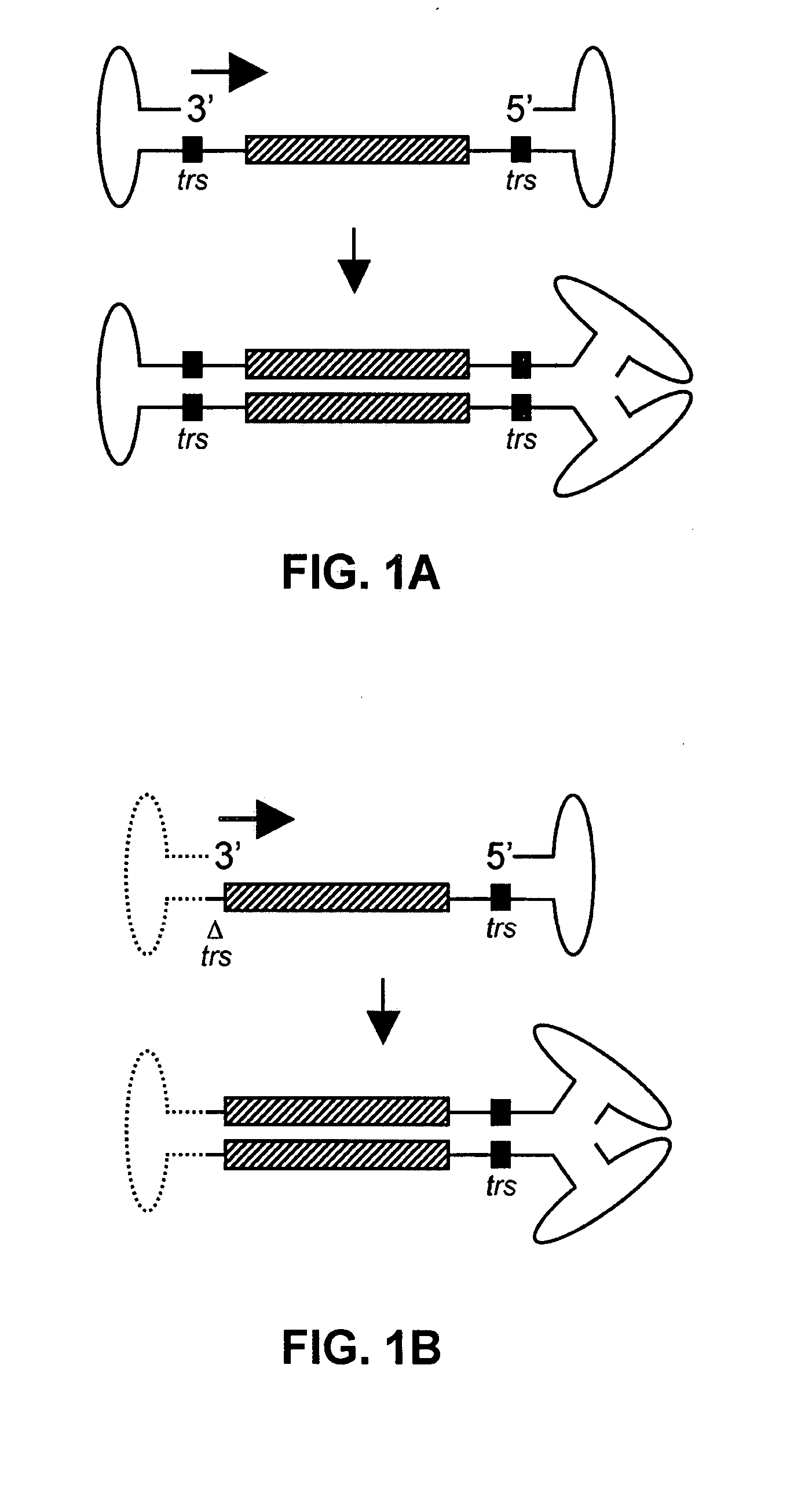Self-complementary parvoviral vectors, and methods for making and using the same
a parvovirus and vector technology, applied in the field of self-complementary parvovirus vectors, can solve the problems of major limiting factors of conventional aav vectors, genetic instability, labor-intensive purification and enrichment steps, etc., and achieve the effect of enhancing the genetic stability of parvovirus vectors
- Summary
- Abstract
- Description
- Claims
- Application Information
AI Technical Summary
Benefits of technology
Problems solved by technology
Method used
Image
Examples
example 1
Strategy for scAAV Vector Particle Generation
[0132] The following protocol for self-complementary adeno-associated virus (scAAV) vector particle generation provides preparations solely containing packaged dimer molecules. The prototype of scAAV vector genome is modified by replacing one of the two DNA replication / packaging signals (ITRs) flanking the genome with a truncated version with little or no homology to the other ITR (FIG. 1B). This truncated ITR no longer contains the 6 bp trs element, which during replication of the wild-type viral genome is nicked, resulting in formation of monomer DNA forms (FIG. 1B). Moreover, the use of two ITRs with minimal DNA sequence homology minimizes the risk of gene conversion between the intact and the truncated ITR, which could otherwise result in restoration of the trs site at both ends. Heterologous AAV ITRs can either be derived from naturally occurring serotypes of AAV, which differ in DNA sequence, for instance AAV serotypes 2 and 4. Int...
example 2
Preparation of Small Self-Complementary AAV Vector Genomes
[0135] A small self-complementary AAV vector genome was generated that included a shRNA expression cassette of approximately 650 basepairs in size. In DNA extracted from cells transfected with this vector construct and plasmids providing AAV and Adenovirus helper functions, the expected replicative intermediates were detected, confirming that despite its significantly reduced size, the small AAV vector genome replicated correctly.
[0136]FIG. 3 illustrates extrachromosomally replicated DNA according to some embodiments. The DNA was extracted from cells transfected with a small self-complementary vector genome (lane 1), an approximately 3-fold larger also self-complementary vector (lane 2), and a standard AAV vector construct (lane 3). Note that all cells were also transfected with AAV and Adenovirus helper plasmids. The typical replicative intermediates RF1 and RF2, as well as ‘double-stranded’ DNA forms, were only observed f...
example 3
Preparation of Virion Particles Containing AAV Vector Genomes
[0137]FIG. 4 illustrates formation of virions and their associated capsid density profiles in a CsCl gradient according to some embodiments. The numbers of AAV capsids found in CsCl gradient fractions and their densities (g / ml) are provided. The capsids were obtained through the separate packaging of a small self-complementary vector in (‘sc mini length’), a 3-fold larger version (‘sc full length’), and two standard AAV vectors of 3.6 (‘ss control (gfp)’) and 4.6 (‘ss full length’) kilobases. Peaks of full capsids are highlighted by the numbers, representing the total length of vector DNA encapsidated (3.3 kb for the described small vector).
[0138] AAV vector genomes were packaged into AAV-2 capsids, and the resulting particles were fractionated by CsCl gradient density centrifugation and analysed for total capsid numbers by A20 Elisa (Grimm et al., Gene Ther., (1999) 6:1322-1330. A peak of full capsids was observed that ...
PUM
| Property | Measurement | Unit |
|---|---|---|
| temperature | aaaaa | aaaaa |
| temperature | aaaaa | aaaaa |
| pH | aaaaa | aaaaa |
Abstract
Description
Claims
Application Information
 Login to View More
Login to View More - R&D
- Intellectual Property
- Life Sciences
- Materials
- Tech Scout
- Unparalleled Data Quality
- Higher Quality Content
- 60% Fewer Hallucinations
Browse by: Latest US Patents, China's latest patents, Technical Efficacy Thesaurus, Application Domain, Technology Topic, Popular Technical Reports.
© 2025 PatSnap. All rights reserved.Legal|Privacy policy|Modern Slavery Act Transparency Statement|Sitemap|About US| Contact US: help@patsnap.com



